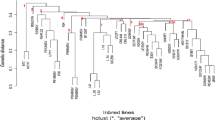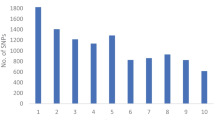Abstract
The classification of maize inbred lines into heterotic groups is an important undertaking in hybrid breeding. The objectives of our research were to: (1) separate selected tropical mid-altitude maize inbred lines into heterotic groups based on grain yield data; (2) assess the genetic relationships among these inbred lines using amplified fragment length polymorphism (AFLP) and simple sequence repeat (SSR) markers; (3) examine the consistency between yield-based and marker-based groupings of the inbred lines. Thirty-eight tropical mid-altitude maize inbred lines were crossed to two inbred line testers representing the flint and dent heterotic pattern, respectively. The resulting testcrosses were evaluated in a trial at three locations for 2 years. Significant general combining ability (GCA) and specific combining ability (SCA) effects for grain yield were detected among the inbred lines. The tester inbred lines classified 23 of the 38 tested inbred lines into two heterotic groups based on SCA effects and testcross mean grain yields. This grouping was not related to endosperm type of the inbred lines. The outstanding performance of testcrosses of the remaining 15 inbred lines indicates the presence of significant genetic diversity that may allow the assignment of the lines into more than two heterotic groups. Diversity analysis of the 40 maize inbred lines using AFLP and SSR markers found high levels of genetic diversity among these lines and subdivided them into two main groups with subdivision into sub-groups consistent with breeding history, origin and parentage of the lines. However, heterotic groups formed using yield-based combining ability were different from the groups established on the basis of molecular markers. Considering the diversity of the genetic backgrounds of the mid-altitude inbred lines, the marker-based grouping may serve as the basis to design and carry out combining ability studies in the field to establish clearly defined heterotic groups with a greater genetic similarity within groups.


Similar content being viewed by others
References
Ajmone-Marsan P, Castiglioni P, Fusari Fl, Kuiper M, Motto M (1998) Genetic diversity and its relationship to hybrid performance in maize as revealed by RFLP and AFLP markers. Theor Appl Genet 96:219–227
Bernardo R (2001) Breeding potential of intra- and inter-heterotic group crosses in maize. Crop Sci 41:68–71
CID (1993) Crop improvement division activity report and work plan for 1993. International Institute of Tropical Agriculture, Ibadan, Nigeria
Cochran WG, Cox GM (1960) Experimental designs. John Wiley and Sons, New York
Dice LR (1945) Measures of the amount of ecologic association between species. Ecology 26:297–302
Enoki H, Sato H, Koinuma K (2002) SSR analysis of genetic diversity among maize inbred lines adapted to cold regions of Japan. Theor Appl Genet 104:1270–1277
Everett LA, Eta-Ndu JT, Ndioro M, Tabi I, Kim SK (1994a) Registration of 18 first-cycle tropical midaltitude maize germplasm lines. Crop Sci 34:1422
Everett LA, Eta-Ndu JT, Ndioro M, Tabi I, Kim SK (1994b) Registration of 19 second-cycle tropical midaltitude maize germplasm lines. Crop Sci 34:1419–1420
Everett LA, Eta-Ndu JT, Ndioro M, Walker P (1995) Combining ability among source populations for tropical mid-altitude maize inbreds. Maydica 40:165–171
Hallauer AR, Russell WA, Lamkey KD (1988) Corn breeding. In: Sprague GF, Dudley JW (eds) Corn and corn improvement. Agronomy Monograph no. 18, 3rd edn. ASA-CSSA-SSSA, Madison, Wis., pp 463–565
IITA (1984) Research highlights for 1983. International Institute of Tropical Agriculture, Ibadan, Nigeria
Kempthorne O (1957) An introduction to genetic statistics. John Wiley and Sons, New York
Kim SK, Khadar F, Fajemisin J, Efron Y, Everette LA (1985) Disease resistance maize breeding for mid-altitude ecology in Africa. Agron Abstr, ASS, Madison Wis., p 75
Kim SK, Ajala SO, Brewbaker JL (1999) Combining ability of tropical maize germplasm in West Africa III. Tropical maize inbreds. Maydica 44:285–291
Lanza LLB, de Souza CL Jr, Ottoboni LMM, Vieira MLC, de Souza AP (1997) Genetic distance of inbred lines and prediction of maize single-cross performance using RAPD markers. Theor Appl Genet 94:1023–1030
Lu H, Bernardo R (2001) Molecular marker diversity among current and historical maize inbreds. Theor Appl Genet 103:613-617
Lűbberstedt T, Melchinger AE, DuBle C, Vuylsteak M, Kuiper M (2000) Relationships among early European maize inbreds. IV. Genetic diversity revealed with AFLP markers and comparison with RFLP, RAPD and pedigree data. Crop Sci 40:783–791
Mantel N (1967) The detection of disease clustering and a generalized regression approach. Cancer Res 27:209–220
Melchinger AE (1999) Genetic diversity and heterosis. In: Coors JG, Pandey S (eds) The genetics and exploitation of heterosis in crops. CSSA-SP, Madison, Wis., pp 99–118.
Melchinger AE, Gumbler RK (1998) Overview of heterosis and heterotic groups in agronomic crops. In: Lamkey KR, Staub JE (eds) Concept and breeding of heterosis in crop plants. CSSA-SP, publication no. 25, Madison, Wis. pp 29–44
Messmer MM, Melchinger AE, Boppenmaier J, Brunklanus-Jung E, Herrmann RG (1992) Relationships among early European maize (Zea mays L.) inbreds. I. Genetic diversity among flint and dent lines revealed by RFLPs. Crop Sci 32:1301–1309
Mumm RH, Dudley JW (1995) A PC SAS computer program to generate a dissimilarity matrix for cluster analysis. Crop Sci 35:925–927
Parentoni SN, Magalhaes JV, Pacheco CA, Santos MX, Abadie T, Gama EEG, Guimaraes PEO, Meirelles WF, Lopes MA, Vasconcelos MJV, Paiva E (2001) Heterotic groups based on yield-specific combining ability data and phylogenetic relationship determined by RAPD markers for 28 tropical maize open pollinated varieties. Euphytica 121:197–208
Pejic I, Ajmone-Marsoan P, Morgante M, Kozumplick V, Castiglioni P, Taramino G Motto M (1998) Comparative analysis of genetic similarity among maize inbred lines detected by RFLPs, RAPDs, SSRs and AFLPs. Theor Appl Genet 97:1248–1255
Rohlf FJ (1998) ntsys-pc. Numerical taxonomy and multivariate analysis system, version 2.00. Exeter Software, Setauket, N.Y.
Saghai Maroof MA, Biyashev RM, Yang GP, Zhang Q, Allard RW (1994) Extraordinarily polymorphic microsatellite DNA in barley: species diversity, chromosomal locations, and population dynamics. Proc Natl Acad Sci USA 91:5466–5470
SAS Institute (1997) sas/stat software: changes and enhancement through release 6.12. SAS Institute, Cary, N.C.
Senior MJL, Murphy JP, Goodman MM, Stuber CW (1998) Utility of SSRs for determining genetic similarity and relationships in maize using an agarose gel system. Crop Sci 38:1088–1098
Smith JSC, Chin EC, Shu H, Smith OS, Wall SJ, Senior ML, Mitchell SE, Kresovich S, Ziegle J (1997) An evaluation of the utility of SSR as molecular markers in maize (Zea mays L.): comparisons with data from RFLPs and pedigrees. Theor Appl Genet 95:163–173
Vasal SK, Srinivasan G, Han GC, Gonzalez F (1992a) Heterotic patterns of eighty-eight white subtropical CIMMYT maize lines. Maydica 37:319–327
Vasal SK, Srinivasan G, Pandey S, Cordova HS, Han GC, Gonzalez F (1992b) Heterotic patterns of ninety-two white tropical CIMMYT maize lines. Maydica 37:259–270
Vos P, Hogers R, Bleeker M, Reijans M, van de Lee T, Hornes M, Frijters A, Pot J, Peleman J, Kuiper M, Zabeau M (1995) AFLP: a new technique for DNA fingerprinting. Nucleic Acids Res. 23:4407–4414
Warburton ML, Ianchun XX, Crossa J, Franco J, Melchinger AE, Frisch M, Bohn M, Hoisington D (2002) Genetic characterization of CIMMYT inbred maize lines and open-pollinated populations using large-scale fingerprinting methods. Crop Sci 42:1822–1840
Acknowledgements
This research was conducted at the International Institute of Tropical Agriculture (MS no. IITA 03/015/JA) and financed by IITA. The authors express their appreciation to all staff members that carried out laboratory analyses and those that participated during planting, data recording, harvesting and management of the trial at three locations.
Author information
Authors and Affiliations
Corresponding author
Additional information
Communicated by H.H. Geiger
Rights and permissions
About this article
Cite this article
Menkir, A., Melake-Berhan, A., The, C. et al. Grouping of tropical mid-altitude maize inbred lines on the basis of yield data and molecular markers. Theor Appl Genet 108, 1582–1590 (2004). https://doi.org/10.1007/s00122-004-1585-0
Received:
Accepted:
Published:
Issue Date:
DOI: https://doi.org/10.1007/s00122-004-1585-0




